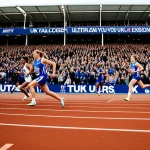Key Mechanisms Through Which UK Sports Media Shape Public Perception
UK sports media influence hinges significantly on media framing and selective coverage practices. Decisions on which events or athletes to highlight directly shape public focus, often emphasizing high-profile successes or controversies while sidelining less sensational stories. This selective spotlight can skew the narrative, affecting how fans and the wider public gauge sports and athletes.
The tone and language applied in athlete stories further impact perception. Positive language in portraying an athlete’s determination or skill can elevate their public image, whereas negative or critical tones may cast doubt on their abilities or character. For example, success stories tend to be framed with heroic or inspirational language, while failures might be described with harsher, more judgmental terms.
Additional reading : How Can You Get Involved in UK Sports Events?
Another critical factor is the portrayal of athlete’s personal traits alongside their professional achievements. Media often intertwine assessments of personal characteristics—such as temperament, background, or off-field behavior—with athletic performance. This portrayal can humanize athletes or reinforce stereotypes, thereby influencing public attitudes in ways that extend beyond sports results.
Together, these mechanisms show how UK sports media shape public perception not just by reporting events but through nuanced storytelling techniques embedded in coverage decisions, tone, and athlete depiction.
Also to see : How Does the Premier League Impact the UK’s Economy?
Differences Between Traditional and Digital Sports Media Influence
The divide between traditional sports media and digital sports media is stark in terms of reach, immediacy, and audience engagement. Traditional sports media, such as newspapers, television, and radio, maintain a more controlled editorial process and established audience base. Their media coverage practices are often slower but come with formal credibility. In contrast, digital sports media thrives on real-time updates and interactive formats, leveraging the internet and social media impact to reach diverse and global audiences instantly.
Social media platforms play a pivotal role, allowing athletes to bypass traditional filters and engage directly with fans. This ability to shape their own narratives contrasts with the curated athlete portrayal seen in traditional outlets. Athletes can share personal insights or respond immediately to events, influencing public perception without intermediary framing.
Online commentary and viral narratives also amplify stories far beyond the original scope. While this can democratize sports discourse, it introduces challenges around verifying accuracy and managing misinformation. The rapid spread through digital channels demands that both media consumers and professionals remain vigilant about the quality and balance of coverage in the evolving sports media landscape.
The Role of Stereotypes and Athlete Identity in Media Coverage
Media stereotypes in UK sports media influence public perception by framing athletes through recurring, simplified narratives. Common media stereotypes include portraying male athletes as powerful and aggressive, while female athletes often receive emphasis on appearance or emotional traits rather than skill. Such portrayals affect how different genders are valued in sport.
Athlete identity—combining factors like race, nationality, and gender—is frequently filtered through these stereotypes. For example, athletes from minority backgrounds may face coverage that reflects cultural or racial biases, sometimes highlighting their “otherness” rather than sporting merit. This can lead to differential treatment, where similar performances elicit contrasting media reactions depending on the athlete’s identity.
The long-term impact of repeated framing by UK sports media influence public attitudes by reinforcing stereotypes and shaping expectations about athlete roles. Over time, this entrenches certain biases among audiences, potentially limiting recognition and support for diverse talent. Addressing these patterns within media coverage practices is crucial to fostering fairer and more nuanced athlete portrayal that respects individual identity beyond superficial stereotypes.
Real-World Examples and Case Studies
UK sports media influence shapes public perception vividly through coverage of high-profile athletes. Consider how the media’s portrayal of Jessica Ennis-Hill shifted after her Olympic success. Positive media framing highlighted her dedication, amplifying public admiration. Conversely, scrutiny intensified when she faced setbacks, showcasing how media coverage practices toggle between celebration and critique.
Another example lies with the contrasting depiction of footballer Marcus Rashford. Media spotlighting his activism alongside athletic achievements contributed to a favorable public image, demonstrating the power of intertwining personal traits with sports coverage. However, negative commentary during poor performances illustrates how tone and language applied in athlete stories can quickly alter public sentiment.
Sports media case studies reveal that narratives, whether positive or negative, tend to focus not only on performance outcomes but also personal character, highlighting the multifaceted nature of athlete portrayal. These cases exemplify how public perception shifts correspond closely with the media’s selective coverage decisions and framing strategies.
Such examples underscore the importance of responsible media coverage practices that balance celebrating success with fair, contextual critique, ensuring athletes are portrayed holistically rather than through narrow or sensational lenses.
Societal Impacts and Broader Consequences
UK sports media influence extends beyond immediate coverage to shape the broader societal impact of sports media on both public opinion and athlete well-being. Intense media scrutiny can significantly affect athlete mental health, as relentless exposure to both praise and criticism places immense pressure on athletes. The portrayal of athletes’ personal traits alongside their professional performance, as discussed earlier, adds layers of complexity to their public image, often magnifying stress and anxiety.
Moreover, the way sports media frame stories influences youth and aspiring athletes by shaping their perceptions of success and failure. Positive media coverage can inspire participation and foster ambition, while biased or negative framing may discourage involvement or perpetuate unrealistic expectations. This dynamic illustrates the powerful role media coverage practices play in driving sports engagement within communities.
Finally, sports media impact public discourse by contributing to wider social debates, such as those addressing gender equality and racial representation. Media stereotypes often permeate these discussions, either reinforcing or challenging societal norms. Understanding these broader consequences emphasizes the need for responsible reporting that considers both individual athletes’ welfare and the social implications of media narratives.
Insights from Academic Research and Industry Experts
Academic research and expert commentary consistently highlight that UK sports media influence extends beyond mere reporting to actively shape narratives and public understanding. Studies in media studies UK reveal how media coverage practices rely heavily on framing techniques that prioritize sensationalism and emotional appeal, which can distort athlete portrayal and skew audience perceptions.
Experts stress the importance of ethical reporting, emphasizing balanced coverage that respects both performance and personal context. Research shows that reductive or biased storytelling often exacerbates stereotypes, influencing the mental health and social reception of athletes. For instance, media analysts point out that disproportionate focus on controversies or failures can damage an athlete’s public image unfairly, calling for nuanced and responsible coverage.
Furthermore, industry professionals recommend adopting more transparent editorial guidelines and promoting media literacy among consumers. Academic work documents how increased awareness of framing effects empowers audiences to critically evaluate sports media content. This approach aligns with enhancing trust in journalism and fostering a healthier sports culture, ultimately improving both athlete welfare and public engagement.
These insights offer valuable guidance to UK sports media practitioners seeking to refine their media coverage practices and contribute positively to public discourse surrounding sports and athletes.











